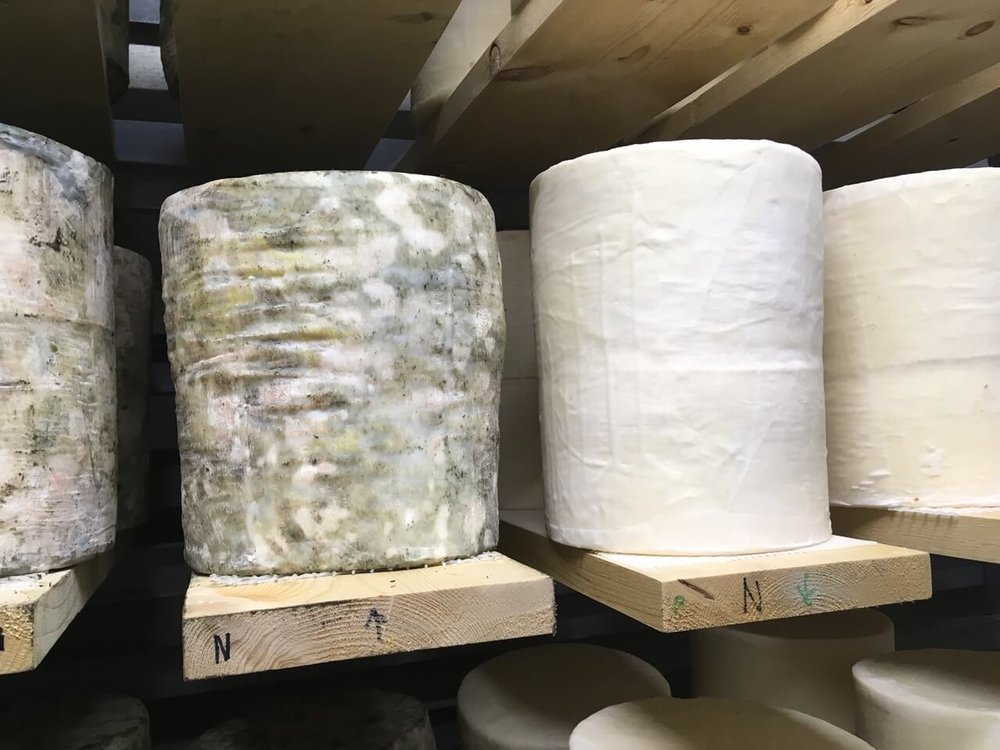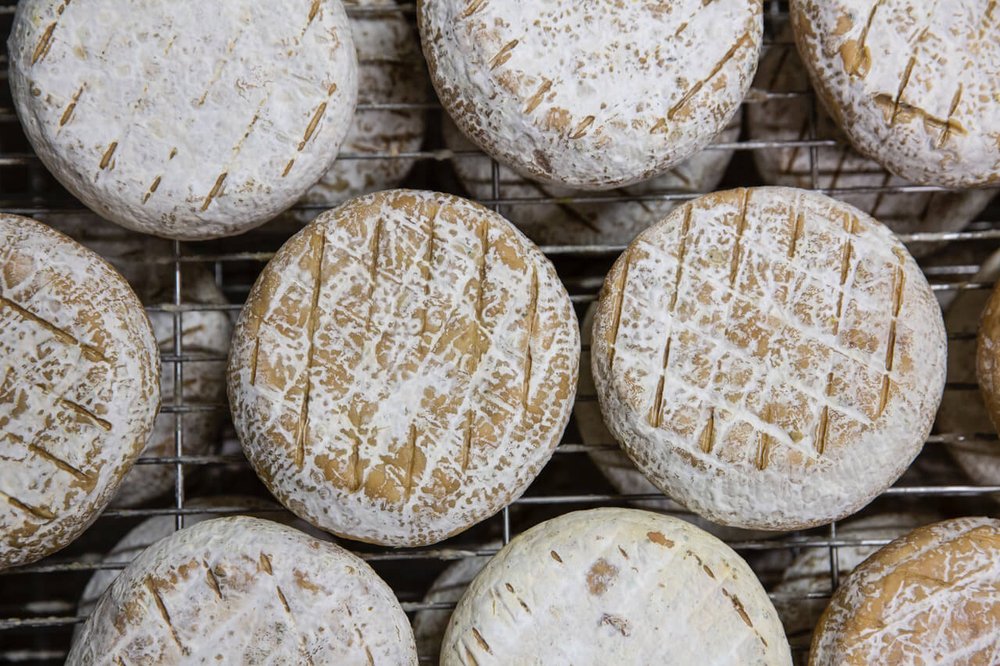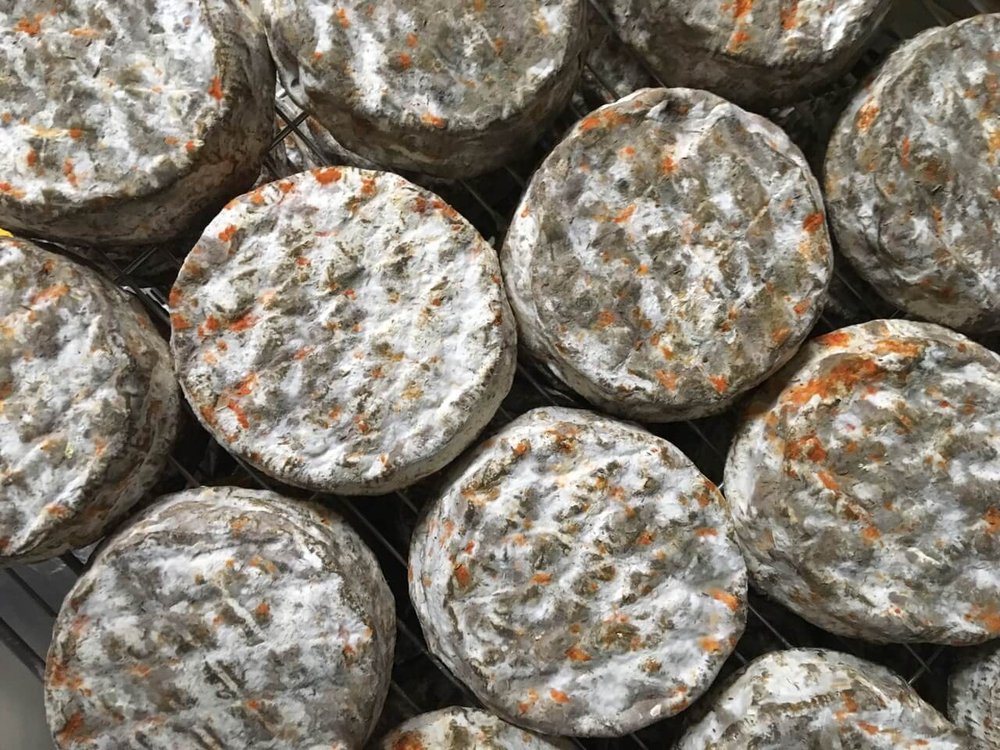Fluffy mold photo credit Murray’s Cheese
“Affinage is simply the art of aging cheese,” explains Josh Windsor, Affineur for Murray’s Cave Aged program in Long Island City, New York. “It can be as simple as just putting cheese in a plastic bag, vacuum sealing it, putting it on a shelf, and letting it age out to the profile you want, or as complicated as introducing 16 different techniques to prime the surface of the cheese.”
Windsor is one of a team of affineurs for Murray’s who create such gems as Greensward, 80:10:10, and Stockinghall Cheddar, as well as offer affinage services to cheesemakers around the world, maintaining environments and treatments consistent with what those cheeses would experience in their places of origin.
Washed cheeses aging photo credit Murray’s Cheese
What is Affinage?
In French, the term “affinage” literally means “to refine.” Where cheese is concerned, it is the process of taking young, squeaky portions of freshly pressed curds that have little personality and transforming them over time and attention into all the myriad varieties of cheese we know and love.
According to Windsor, there is little difference at the beginning of the cheesemaking process between that which will become blue cheese, and that which will become brie: “(Before affinage,) you basically have a bunch of dairy protein and fat that is salty, because you salt it, and it’s sour, because you acidify it. And there’s not a lot else,” he explains. It is affinage, through the choices, actions, and inactions of the affineur where the particular, transformative alchemy occurs. “All of the things that an affineur does help guide the aromatic profile and whatever textural changes come along with that, whether it’s a hard crumbly cheese with notes of horseradish and mustard, or whether it’s a soft, oozy cheese that smells like foot and tastes like beer,” says Windsor.
For one whose job description indicates refinement of cheese, Windsor playfully entitles himself a bit differently. When I initially came across him on Instagram via the handle @theaffineur, I was inclined to dig deeper. When his profile description indicated “mold farmer,” I knew this was someone I had to speak with. (Windsor’s Instagram account itself is also a great place to start for an Affinage 101 education. Scratch that—it’s more like Affinage 201, with a prerequisite for at least basic Latin if not also Classic Literature.)
From Windsor’s Affinage presentation at Murray’s Boot Camp, (which I was fortunate to attend,) and the generous time he spent answering my numerous questions, here is a basic primer for those interested in dipping at least their toes into the vast depths that comprise the fascinating world of affinage.
Stockinghall Cheddar photo credit Murray’s Cheese
Cheese Can Be Aged in Many Different Environments
Yes, even vacuum-sealed in plastic. As alluded to in Windsor’s opening statement above, affinage isn’t just that which takes place in dedicated cheese caves or cellars. There are elements of aerobic and anaerobic activity that take place during the aging process, and even conventional cheddars haven’t concluded their development once they are wrapped.
Windsor used an example of two different cheddars that begin life the same way: Stockinghall, which is coated in lard and wrapped in cheesecloth, and Blockinghall, which is formed into a square and vacuum sealed. Two identical milk profiles and curd structures, two different outcomes, but Blockinghall is going through just as much development as its “fancier” cousin, which benefits from the microbes in the air, while the Blockinghall is still evolving based on microbes already in the cheese. “They’re both aging, but they’re aging in different ways,” says Windsor. “On sealed cheeses—whether it’s wax or a cryovac bag—they’re all going to hold on to their moisture, and the more moisture that’s available the more bioactivity there is, the more microbes that can work in there. Water is a great source of other chemical transactions. So there’s a lot that can still go on from a flavor development standpoint with sealed cheeses.”
Mold on cheese photo credit Murray’s Cheese
Certain Cheeses Prefer Certain Conditions
The microbial activity that allows for maturation and development to happen in cheese is amplified given certain conditions of both humidity and temperature. All types of cheeses can go through these processes so long as some basic conditions are met, but different types of cheeses have different ideal working conditions. (Mariah Carey’s dressing room requirements have nothing on cheese.)
“You want a cool, damp environment that molds like,” says Windsor, “so high humidity, usually above 90 percent depending on the cheese style, and cave or cellar temp which is usually somewhere around 50 degrees. Each style of cheese, depending on the rind, is going to have different specifics, and some of them have staged aging, where you move them between caves, or otherwise change the environment.”
Some small dairies may make several different types of cheeses all in one space, but Murray’s Caves include 5 different rooms with varied conditions: a washed rind cave, a natural rind cave, a bloomy rind cave, an Alpine cave, and a drying room, or haloir. The temperature in these rooms ranges between 48 degrees and 57 degrees Fahrenheit, with a humidity level between 88 to 98 percent. (Note that even the drying room maintains a humidity percentage in the mid-50s.)
Various stages of aging photo credit Murray’s Cheese
Different Microbes Work in Different Phases
Not all microbial processes start happening all at once the minute the cheese hits the cave. All of the different microbes that contribute to the ripening of cheese are essentially competing for nutrients that the cheese provides, seeking out different nutritional aspects of the cheese, and process those nutrients in different ways given different conditions. This creates different phases of microbial life on aging cheese wheels, which the affineur may work to either encourage or suppress, based on the microbe, and the desired outcome of the cheese. “We’re swabbing the environment and inspecting the cheese and making sure nothing bad is growing on it,” says Windsor, “but everything else, which is the vast majority of the microbes you throw on cheese, we’re encouraging.” Some very innocuous-looking rinds that you would find on cheeses once they hit the retail market have gone through a veritable rainbow of transformation during their time in the cheese caves.
Windsor further explains: “If you have 1000 to 10,000 microbes growing over the course of a year they come in phases. So they’ll populate the cheese, and for a few weeks one will really be dominant, and we’ll start prepping the environment for another microbe to have the advantage. Because cheese is basically preserving the nutrient content of milk, we create this super nutrient-rich environment for these microbes to compete against each other on. The benefit to us is that it makes the cheese delicious.”
More wheels aging photo credit Murray’s Cheese
Cheese Caves Have Their Own Terroir
Terroir isn’t only limited to the seasonal and environmental factors that affect the milk itself. (For further reading on this topic, see How to Find the Right Season to Buy Your Favorite Cheese.) Beyond whether the affineur is intentionally introducing specific microbes to the cheese’s surface, or letting the natural elements in the environment do the ripening work, there is more to the terroir of cheese caves and cellars. Geography plays its own part, but so too do factors such as airflow, air exchange, (how the Ph of the air is changing within the cave as cheeses ripen,) seasonality of the microflora, and whether different types of cheeses are aging in the same environment, in which cross-pollination can occur.
“Our terroir is the terroir of Long Island City,” says Windsor. “We’re working with cheeses from many different manufacturers, so we’re inheriting some of the terroirs. Our environment is also part of our production facility. We have a big e-commerce business, and we have a cut-to-order facility with about 300-400 cheeses that are all getting broken down. All of those cheeses are introducing mold spores into the environment, so we are constantly seeding our caves, especially our natural caves, right off of that facility with this microbial diversity of the world.”
Colorful blooms photo credit Murray’s Cheese
Affinage Relies on Experimentation
To grossly under exaggerate a point, there is a hell of a lot of science going on at the heart of affinage, and at several points during my own affinage education with Windsor, I questioned whether I was even qualified to have a conversation with him, much less synthesize his wisdom into a coherent narrative.
But as he described upfront, affinage is also an art, one that is very much based in experimentation, especially in the U.S., where he lamented an unfortunate lack of consistent education and training available to burgeoning affineurs. But there’s an upside, according to Windsor: “It’s a lot of trial and error, but the American marketplace likes novelty, it likes new, it likes to explore. It’s very accepting of whimsical creations and things that deviate from the norm, so a lot of cheese producers are exploring this, are breaking from traditions, and are creating new styles of cheese, and learning themselves how to age them.”
For further reading on cheese-making processes see From Milk to Wheel: Cheesemaking 101.
